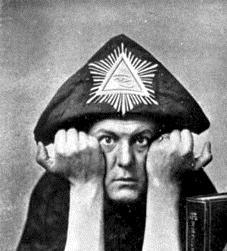Faust Alick
As you may remember, the last column gave a brief overview of the early life of the professional cult leader Aleister Crowley, who, upon having an epiphany about the nature of the universe in Egypt and giving his firstborn daughter what is quite possibly the most ridiculous name conceivable (not even poor Dovahkiin Tom Kellermeyer can hope to compare), split from the Hermetic Order of the A∴ A∴ Golden Dawn and founded his own order, the (you apparently stop bothering with trivial matters like pronounceability after Horus himself instructs you in the truths of the world). I must in addition note here that like the Order of the Golden Dawn, Alick himself and his cult have also featured as antagonists in fiction: Crowley, unsurprisingly, is presented as an eccentric magician or sometimes a demon, though the only fictional reference to A∴ A∴ that I am aware of is likely coincidental (the character -- if it can be called that -- in question is not a fanatical cult but a giant, mechanical monstrosity resembling a queen ant, capable of injecting eggs inside its victims to create clones). In any case, much like a certain group of contract killers atop a certain mountain fortress, Crowley's cult was centered around a singular and exceedingly simple rule: "Do what thou wilt shall be the whole of the Law." Of course, being a cultist was much more difficult in practice, and initiate members were expected to rigorously study various religious and magical texts at their own discretion, though often with the assistance of a master. It was essentially a magical PhD, with qualification rituals waiting at the end (so if you were daunted by the simple written examinations of Golden Dawn mentioned last week, you had better not have any hopes of flinging fireballs around anytime soon).
 At this point I should mention that ranks in the A∴ A∴ were primarily based on the nodes of the Kabbalistic Sephirot. In addition to being the infamous antagonist of Final Fantasy VII (the secondary theme of this column, if you haven't figured it out yet, is fictional villains), the Sephirot is a religious motif expressing the attributes of the Abrahamic God: Chesed represents the grace of God, Binah corresponds to understanding, Chochmah is infinite wisdom and so on. While initially playing an important role in Judaism, it has since been adopted by other religions (and, curiously, Christian Kabbalah is called "Cabbalah" while Hermetic Kabbalah is called "Qabbalah," so you have the first letters coded for your convenience). In any case, Qabbalah as practiced by Crowley was a motley mixture of every religion he was exposed to and bore little resemblance to the school of thought it originated from: instead of the wisdom of God, Chochmah in Qabbalah represented Thoth, Vishnu, Odin, Uranus, Athena, Shiva lingam and so on. Nodes of the Qabbalah also allowed initiates to "level up" through the Tree of Life, with neophytes beginning at Malkuth (the Kingdom, corresponding to the created universe) and moving their way up to Keter (the Crown, originally representing the oneness of God). Gematria, a system of numerology studied by Judaistic scholars, also played a vital role in Hermetic magic, with certain numbers (93 and 418 in particular) representing important concepts (you may note as well that the so-called Number of the Beast, 616 or 666, is likely another product of this system, though generally associated with Nero and not the Devil). Still, if you succeeded in your quest to rise through the ranks, you eventually got a genius (as in the Roman personal deity), who further guided you to truth (or drove you mad, so that you named your son Ausare Mahakala Taranis Asterion Ometeotl Amatsu-Mikaboshi, or something of the sort).
At this point I should mention that ranks in the A∴ A∴ were primarily based on the nodes of the Kabbalistic Sephirot. In addition to being the infamous antagonist of Final Fantasy VII (the secondary theme of this column, if you haven't figured it out yet, is fictional villains), the Sephirot is a religious motif expressing the attributes of the Abrahamic God: Chesed represents the grace of God, Binah corresponds to understanding, Chochmah is infinite wisdom and so on. While initially playing an important role in Judaism, it has since been adopted by other religions (and, curiously, Christian Kabbalah is called "Cabbalah" while Hermetic Kabbalah is called "Qabbalah," so you have the first letters coded for your convenience). In any case, Qabbalah as practiced by Crowley was a motley mixture of every religion he was exposed to and bore little resemblance to the school of thought it originated from: instead of the wisdom of God, Chochmah in Qabbalah represented Thoth, Vishnu, Odin, Uranus, Athena, Shiva lingam and so on. Nodes of the Qabbalah also allowed initiates to "level up" through the Tree of Life, with neophytes beginning at Malkuth (the Kingdom, corresponding to the created universe) and moving their way up to Keter (the Crown, originally representing the oneness of God). Gematria, a system of numerology studied by Judaistic scholars, also played a vital role in Hermetic magic, with certain numbers (93 and 418 in particular) representing important concepts (you may note as well that the so-called Number of the Beast, 616 or 666, is likely another product of this system, though generally associated with Nero and not the Devil). Still, if you succeeded in your quest to rise through the ranks, you eventually got a genius (as in the Roman personal deity), who further guided you to truth (or drove you mad, so that you named your son Ausare Mahakala Taranis Asterion Ometeotl Amatsu-Mikaboshi, or something of the sort).
On that note I shall end my column, since I am also including a picture and do not want to impose on my fellow columnist's space. This is Crowley's famous hat, featuring a symbol associated with the Eye of Providence -- I also recommend looking up his ceremonial clothes, many of which are equally interesting.